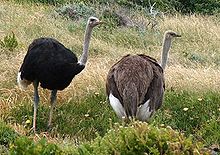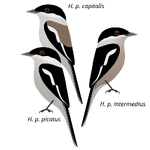This article contains made-up species!
This article contains made-up species not found on Earth. They will be highlighted in pink.
| Ostriches | |
|---|---|

| |
| Adult Ostriches, male and female | |
| Scientific classification | |
| Kingdom: | Animalia |
| Phylum: | Chordata |
| Class: | Aves |
| Infraclass: | Palaeognathae |
| Order: | Struthioniformes Latham, 1790 |
| Family: | Struthionidae (Vigors, 1825)[1] |
| Genus: | Struthio (Linnaeus, 1758)[1] |
| Species | |
| |
Struthionidae is a family of flightless ratite birds which first appeared during the Eocene epoch. It is today represented by the sole living genus Struthio, but also contains several extinct genera.[2] Traditionally the order Struthioniformes contain the world's ratites, but recent genetic analysis has found that the group is not monophletyic, as it paraphyletic in respect to the tinamous.[3][4]
Species[]
There are nine known species from this genus, of which eight are extinct. There are five more possible species of which trace fossils have been found. They are:
- †Struthio coppensi (Early Miocene of Elizabethfeld, Namibia)
- †Struthio linxiaensis (Liushu Late Miocene of Yangwapuzijifang, China)
- †Struthio orlovi (Late Miocene of Moldavia)
- †Struthio karingarabensis (Late Miocene - Early Pliocene of SW and CE Africa) - oospecies(?)
- †Struthio kakesiensis (Laetolil Early Pliocene of Laetoli, Tanzania) - oospecies
- †Struthio wimani (Early Pliocene of China and Mongolia)
- †Struthio daberasensis (Early - Middle Pliocene of Namibia) - oospecies
- †Struthio brachydactylus (Pliocene of Ukraine)
- †Struthio chersonensis (Pliocene of SE Europe to WC Asia) - oospecies
- †Struthio asiaticus, Asian Ostrich (Early Pliocene - Late Pleistocene of Central Asia to China ?and Morocco)
- †Struthio dmanisensis, Giant Ostrich (Late Pliocene/Early Pleistocene of Dmanisi, Georgia)
- †Struthio oldawayi (Early Pleistocene of Tanzania) - probably subspecies of S. camelus
- †Struthio anderssoni - oospecies(?)
- Struthio camelus, Ostrich extant
- Struthio molybdophanes, Somali Ostrich
- Purple-necked Ostrich[made-up sp.]*
- Dwarf Ostrich[made-up sp.]*
Fossil records and egg shell fragments show that the ancestors of this genus originated about 40-58 million years ago (mya) in the Asiatic steppes as small flightless birds. By about 12 mya they had evolved into the larger size of which we are familiar. By this time they had spread to Mongolia and, later, South Africa.[5]
Evolution[]
The genus Struthio used to include the Emu, Rhea, and also the Cassowary, until they each were placed in their own genera.[1]
Footnotes[]
- ^ a b c Gray, George Robert (1855)
- ^ Mayr, G. (2009). Paleogene fossil birds. Springer.
- ^ Hackett, S.J. et al. (2008) A Phylogenomic Study of Birds Reveals Their Evolutionary History. Science, 320, 1763.
- ^ Yuri, T. (2013) Parsimony and model-based analyses of indels in avian nuclear genes reveal congruent and incongruent phylogenetic signals. Biology, 2:419–44.
- ^ Davies, S. J. J. F. (2003)
References[]
- Davies, S.J.J.F. (2003). "Ostriches". In Hutchins, Michael. Grzimek's Animal Life Encyclopedia. 8 Birds I Tinamous and Ratites to Hoatzins (2 ed.). Farmington Hills, MI: Gale Group. p. 99. ISBN 0 7876 5784 0.
- Gray, George Robert (1855). Catalogue of the Genera and Subgenera of Birds contained in the British Museum (PDF). Red Lion Court, Fleet Street, London, UK: Taylor and Francis. p. 109.

|
This article is part of Project Bird Taxonomy, a All Birds project that aims to write comprehensive articles on every order, family and other taxonomic rank related to birds. |
}}
| below = • Category • Portal • Outline }}
| This page uses Creative Commons Licensed content from Wikipedia (view authors). Please help by writing it in the style of All Birds Wiki! |
